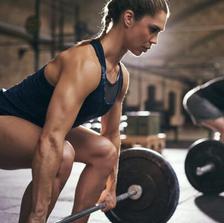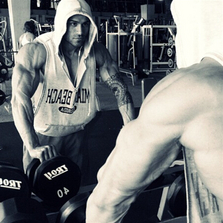- Position:
- Home >
- News >
- Common Problem >
NewsList
-
WELCOME JOINT 2019 CHINA SPORT SHOW(SHANGHAI)
2019.23th,May-26th,May,Zhejiang Zhichi Technology Co., Ltd Joint 2019 China sport show(Shanghai),booth No.:03D310/03D313,Hope meeting with you in our booth.
01 -
8 classic movements for women's fitness
Many MMs want to be good, and they worry that strength training will turn them into muscle women. Therefore, exercise weight loss will try to avoid strength training. In fact, because of the hormones in women, it is difficult for women to train their strength. Strength training, exercise muscles can increase the basal metabolic rate, help fat consumption, and also make the muscles more lined, making people more fit. Therefore, MMs do not have to worry about strength training to make themselves "strong."So, if women want to lose weight through strength training, what can be done? Below, Xiao Bian recommended the classic movements of 8 female fitness.Pick up push ups1. Standing, hands naturally drooping, feet together, knees can be slightly bent.2. Slowly squat until your hands touch the ground. Hold your hands on the ground and straighten your legs back. Then bend your elbows and raise your body down to make an ordinary push-up.3. The legs are retracted, the upper body is upright, the standing position is restored, and then the action is repeated.Dumbbell level lifting1. Take a dumbbell with both hands and stand, legs apart and shoulder width.2. Open both hands to the sides of the body, the elbows are slightly bent, and the two hands are on the same horizontal line.3. Arms are raised along the sides of the body to the top of the head, and the arms can be slightly bent. Then, slowly lay down along the sides of your body. Repeat the action.Dumbbell weight step1. Stand with 8-10 pounds of dumbbells on both hands facing the pedals. The left leg steps on the pedal, stands straight on the left leg, keeps the body straight, the hips tighten, and the right leg stretches back.2. The right leg is recovered and the body is lowered until the right foot is placed on the ground and the left leg is returned to the original position. The legs alternate 10-15 times.Barbell bench press1. Lying on the bench press, holding the barbell, the distance between the two hands is slightly wider than the shoulder, the elbow is bent at 90 degrees, and the chest, the two forearms and the barbell form a rectangle.2. Slowly push the barbell, push it to the high point, then slowly lower the barbell. When you lower it, the barbell touches the chest, and then presses it, repeating the action about 10 times.Neck squat1. Go to the stand, raise your arms under the barbell, cross your arms, lift your elbows, and hold the barbell with your hands to control it.2. Lift the barbell from the stand and take a step back to separate your feet and keep your body balanced.3. Bend your knees down until the thighs are below the ground. During the squatting process, keep your head up and your back straight. Then slowly resume the standing position. Repeat the action.Flat dumbbells flying birds1. Sit on a flat bench press with dumbbells in each hand, palms facing each other, push up until the arms are straight and support above the chest.2. The two hand-held dumbbells are dropped to both sides in parallel, the elbows are slightly bent, the dumbbells are dropped until the muscles on both sides of the chest are fully stretched, and the upper arm is lowered to a level below the shoulder. When the dumbbell falls, take a deep breath. Exhale when holding the bell and returning to the original position. Repeat the action.Back supine1. The body is lying on the back, the back of the hands is supported on a slightly higher stool, the two feet are placed on the shorter stool, and the rest of the body is suspended.2. Exhale, relax your shoulders, bend your elbows slowly, and sink your body as much as possible (especially to sink your hips). Stop for 2-3 seconds, then inhale, and force your arms to support your body. Repeat it.Sit up1. The body is lying flat, legs bent to 90 degrees, hands crossed the chest.2. Try to use your chin to get your knees. Shrink the abdomen and keep your chest as close as possible to your knees. Do 10-15 at a time.
 02
02 -
Don't mistake fatigue as strength!
Still taking fatigue as exercise intensity?Many people will use their hard work to measure their training intensity! I always want to go to the gym and I will torture myself. If it doesn't seem like I didn't practice it!Fatigue valueFor those who have certain training knowledge, the above questions should not be a big secret. However, the "fatigue training" that can be seen everywhere makes me wonder if everyone really did the exercise that they really need. Let us explore the following process:First we need to know the importance of muscle strength training!Modern people's living habits (sitting and not working) can easily lead to muscle loss, and muscle loss has a profound impact on physical health and quality of life. Therefore, modern sports training should include training to improve muscle strength and muscle mass. And for muscle and strength training you need to recognize the following:1. Muscle mass is difficult to establish, most people are afraid of too little, not too afraid, you don't need to worry about practicing too strong.2. To stimulate muscle hyperplasia and increase muscle strength, you must have enough training "strength". The so-called intensity can be expressed simply by the weight that can be lifted by one action. In general, 6RM or more is suitable for maximizing muscle strength and muscle mass (high intensity), and 6-12RM is easier to accumulate training volume (medium strength). It is more commonly used for muscle growth. More than 15RM is more suitable for improving muscle endurance (low intensity)!3. To stimulate muscle growth, and thus increase muscle strength, the weight required is actually much heavier than most people think. The general public who uses static life as their main lifestyle is rarely exposed to the intensity of training that stimulates muscle growth or muscle mass throughout the year.a very tired exercise, not necessarily strong enoughYou can use your underpowered exercise to make yourself tired and tired, and it is easy to get hurt, but you still don't have enough "strength".This mistake is not only caused by the general public. Many sports coaches and fitness instructors are also prone to make this mistake. They run slowly on the treadmill, do a lot of light weight, or follow the blood music. Jumping and jumping all the time may feel very good in the middle of the sport, but if you only have this kind of exercise, this kind of training rarely touches a high enough intensity zone."Low-intensity fatigue", how tired, is also a "low-intensity training."People don't have to be strong forever, but if you want training to be effective, there are always times when you have to work hard to increase your strength.Don't take "fatigue" as the "strength" of training.



 03
03 -
General adaptation syndrome
Physical adaptation to training: general adaptation syndromeThe reason why training can improve a person's athletic performance is based on the body's ability to respond to stress. Canadian psychologist Hans Seyle has published a model that is widely used in response to stress in the environment, called general adaptive synthesis. General Adaptation Syndrome (GAS). Since this model can properly describe the body's response to training, this model has now become the basis of training theory.What is the general adaptation syndrome?In order to maintain its stability when the organism receives pressure (defining pressure), the response to stress can be divided into three phases:Alarm: The first creature under pressure will produce a so-called "fighting or flight" reaction, or paralysis. During the alarm phase, the body temporarily reduces the resistance to stress and informs the body to enter the resistance phase (Resistance).Resistance: The body begins to resist stressors and increases tolerance to stressors.Exhaustion: If the pressure source continues to be too long or stronger than the body can load, the body's resistance will decline and enter the fatigue period. At this stage, it will cause harm to the body and even death.If the body does not suffer excessive stress due to stress after entering the fatigue period, the body will begin to recover after the pressure source disappears, and the body's ability to resist the same stressor is increased by the mechanism of super-recovery. Is this mechanism followed? Training is very similar? Yes, in fact, training is appropriate to put the body under pressure (various physical training), so that the body continues to experience the general adaptation syndrome and super-recovery mechanism to increase tolerance to stressors. The result of this time is that the strength is enhanced, the muscles are stronger, and the physical fitness is better! With this understanding, we can try to define the training:Training: A systematic process that increases the body's ability to resist the same stress in the future by constantly exposing the body to appropriate stress.Finally, let's take a look at a few of the training principles built on the above cognitive:1. The intensity of training needs to be adjusted based on the athlete's own abilities. The same menu may be enough for the veterans to provide enough stimulation to make him improve, but for the novice, too much pressure can cause “overtraining” even if it does not cause injury, but there is no way to recover. The process increases resistance to stress.2. The pressure exerted by the training needs to match the athlete's ability to increase (consistent with the goal of the movement). This is also known as the "special" training, the body will only increase the resistance to specific pressures when recovering, so you must know your goals clearly during training.3. The body needs rest. As mentioned earlier, sustained stress can lead to injury or death in the end. Remember, you won't get stronger in practice, you will only get stronger when you practice rest!



 04
04
Tel:0086-0579-89265887
Phone:0086-15382493739
Add:No. 666, Jiuzhou West Road,Yongkang City, Zhejiang Province
E-mail:Lucy@kk-sports.com










